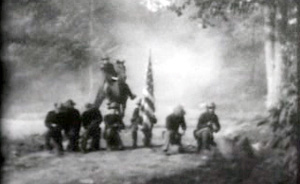talking history | syllabi | students | teachers | puzzle | about us
The Spanish-American War in Motion Pictures
http://memory.loc.gov/ammem/sawhtml/sawhome.html
Created and maintained by the National Digital Library Program team—Motion Picture, Broadcasting, and Recorded Sound Division, Library of Congress, Washington, D.C.
Reviewed Feb. 22–27, 2006.
The Spanish-American War in Motion Pictures, part of the American Memory collections of the Library of Congress, will prove an invaluable Web resource to scholars and students of early film, turn-of-the-century culture, and U.S. military, naval, imperial, and political history. It presents sixty-eight short films produced by the Edison Manufacturing Company and the American Mutoscope & Biograph Company between 1898 and 1901. Users can search for films alphabetically, topically, and by keyword and download them in multiple formats. A short descriptive summary accompanies each film to guide viewing.

Still from the filmed reenactment, "U.S. Infantry supported by Rough Riders
at El Caney" (Thomas A. Edison, Inc.; producer, James H. White). One of
68 motion pictures of the Spanish-American War and the Philippine Revolution.
The Web site features a section entitled “The Motion Picture Camera Goes to War: The Spanish-American War and the Philippine Revolution,” which organizes the collection topically. Each subcategory contains a contextual essay, drawn primarily from Charles Musser’s extensive research, that sets the historical background for the pictures and provides useful details on their production. Those discussions highlight the creative uses of the medium, as well as its limitations, in presenting the “actualities” of war. They call attention to the use of film reenactments (such as Edison’s Skirmish of the Rough Riders (1899), reenacted by National Guardsmen in New Jersey) as well as misrepresentations (such as when Biograph passed off footage of the battleship Massachusetts as the Maine) to capitalize on public interest in war-related events. The presentation also includes a wonderful and rarely discussed dramatic film entitled Love and War (1899), which narrates the tale of an American soldier going to war in Cuba, with remarks on its musical accompaniment.
Although the supplemental analysis effectively illuminates the political and military contexts of the Spanish-American and Philippine-American Wars, the Web site misses an opportunity to draw out the broader cultural implications of the films themselves. The text fails to situate the war pictures in the history of early film and to comment on their non-narrative structure, visual practices, reception, and close ties with print and theatrical culture. Users would do well to consult James Castonguay’s “The Spanish-American War in U.S. Media Culture,” to initiate such discussions.
Furthermore, the site links to The World of 1898: The Spanish-American War, a valuable bank of resources and information on the war’s leading events and personalities, which includes a chronology, bibliographies, maps, and sections outlining the history of Cuba, the Philippines, Puerto Rico, and Spain in relation to the war. Its centerpiece is an overview essay written by the historian David Trask that offers a cogent analysis of the major military and political developments of the war, but it falls short in tracing the war’s impact on notions of gender, race, sexuality, nationhood, and empire, which recent scholarship has deemed integral to understanding the narratives and debates motivating American actions in that moment.
That criticism aside, The Spanish-American War in Motion Pictures documents the first U.S. war captured on film in an easily accessible and thoughtfully organized collection. The fascinating glimpses of the machinery of war, the glories of battle and homecoming, and the struggles of colonial resistance open up an illuminating vantage point to consider the dynamics of war and colonization and its convergence with the development of cinema and modern mass media.
Bonnie M. Miller
Johns Hopkins University
Baltimore, Maryland
